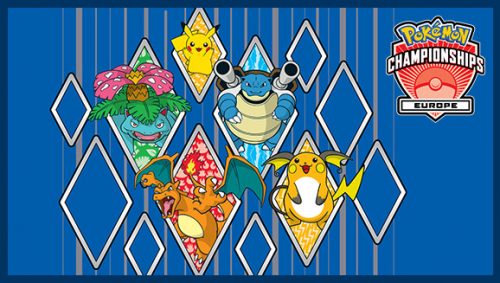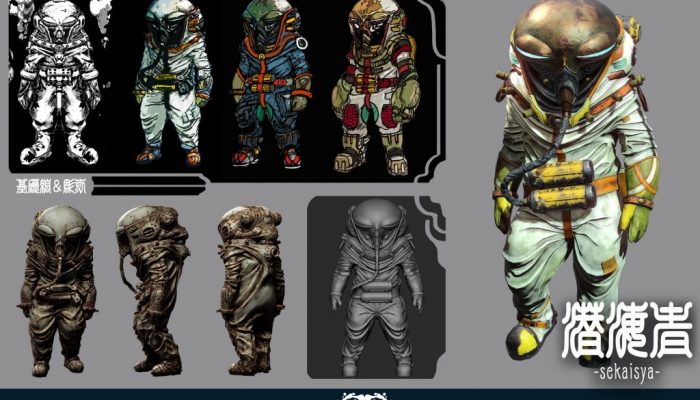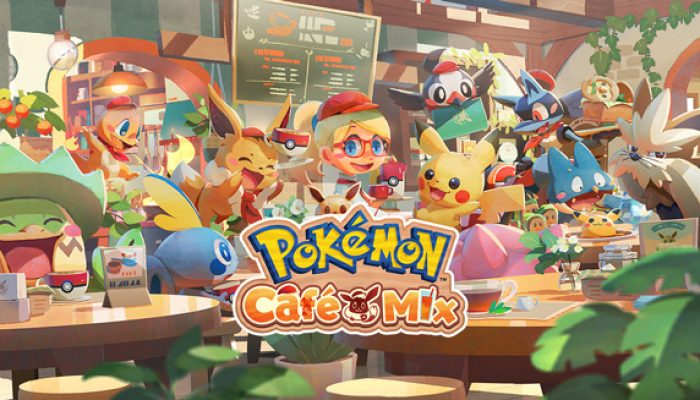 Some flew in all the way from Japan to compete in this first-of-its-kind event.
Some flew in all the way from Japan to compete in this first-of-its-kind event.
☆ NintendObs Weekly – Monday, December 19, 2016 – Sunday, December 25, 2016.

A Look Back at the VG European International Championships
The first Pokémon International Champions have been crowned after a weekend of exciting battles in London. The European International Championship was both the first-ever Pokémon International Championship and the first global tournament featuring Pokémon Sun and Pokémon Moon. Players battled using the 2017 Video Game Championships rules, which feature Pokémon available in the Alola region’s Pokédex and the Double Battle format.
Over 500 video game players competed for cash prizes and a huge number of Championship Points in the Masters Division alone. With top players from Europe, North America, Asia Pacific, and Oceania each receiving Travel Awards to compete in the event, and with other players traveling from as far away as Japan to try their luck, we witnessed some incredibly heated battles for such an early event in the season.
The season is just beginning! Read on to find out who dominated the battlefield and which strategies are likely to be coming soon to a tournament near you.
Tale of the Tournament
Masters Division players started battling on Friday, one day earlier than Junior and Senior Division players. After nine best-of-three Swiss rounds, players with at least seven wins moved on to Saturday. Masters Division Trainers played five additional rounds on Saturday, with their records from Friday carrying over to Saturday. The eight strongest players in each division continued to the single-elimination portion of the tournament on Sunday.
Despite how little time players had to prepare, we saw thoughtful, strategic battles right from the word “Go!” on Friday. Friday’s Masters Division rounds were stacked with experienced players, including 2013 Worlds Runner-up Ryosuke Kosuge, 2015 World Champion Shoma Honami, and 2010–2012 World Champion Ray Rizzo.
The top-4 players from the 2016 Masters Division World Championships all made it through to Saturday, each overcoming the chaotic adjustment of having a major event so much earlier than in past seasons. They were joined by several other star players, including 2016 UK National Champion Alex Gomez and 2013 World Champion Arash Ommati. The global diversity of the field was remarkable, too—Italy, Spain, the United States, the United Kingdom, Germany, Argentina, Singapore, Portugal, Sweden, Japan, Hong Kong, and Chile all had representatives remaining in Saturday’s Masters Division play.
Spain’s Miguel Martí de la Torre, Italy’s Michele Gavelli and Nico Davide Cognetta, the UK’s William Tansley and Ben Kyriakou, Germany’s Tobias Koschitzki, the US’s Tommy Cooleen, and Sweden’s Nils Dunlop made up the top-8 in the Masters Division. After a slow, grinding set, Miguel defeated Nico in the finals after a series of showdowns between mirrored Gastrodon and Celesteela pairings. We’ll take a closer look at trends in the Masters Division shortly, and you can check out the top-8 teams here.
In the Junior Division, Matilda Petrasic came out on top using a team of Primarina, Alolan Marowak, Talonflame, Kartana, Alolan Muk, and Tapu Lele. Murray McKenzie won in the Senior Division, surprising opponents with a team that included several Pokémon that didn’t have much success in the other age divisions. Murray’s winning team included Wishiwashi, Mudsdale, Tapu Koko, Tapu Bulu, Nihilego, and Celesteela.
What’s Hot in Alola?
Many players anticipated chaotic battles full of surprises because the European International Championship so closely followed the launch of Pokémon Sun and Pokémon Moon. Matches on the Battle Spot and in smaller events before the tournament in London had largely been dominated by a handful of powerful Pokémon executing simple offensive strategies. Trainers used Pokémon such as Gyarados that knew Dragon Dance holding Waterium Z, Tapu Koko and Tapu Lele taking advantage of their terrains, and Alolan Marowak, Garchomp, Porygon2, and Celesteela to simplify their battles. Some players even expected this group of Pokémon to be among the best all year, like the 2016 season’s iconic “big six” team.
Top teams largely featured cohesive, defensive groupings of Pokémon. Despite the introduction of the powerful new Z-Moves, battles proved to be slower and more Chess-like than in recent Pokémon Video Game Championship seasons. After a 2016 season where the astonishing power of Primal Reversion and Xerneas made the type chart seem more like a suggestion than reality, the swap to more tactical battles in London likely surprised some players. Defensive moves such as Leech Seed, Toxic, Perish Song, and especially Substitute saw massive surges in popularity as playstyles shifted.
The Ultra Beast Celesteela has undoubtedly cemented its place as one of the most important Pokémon to consider in the 2017 Video Game Championships. Most players are teaching Celesteela both Leech Seed and Substitute, enabling extremely potent endgame win conditions. We saw many battles come down to Trainers struggling to preserve Pokémon with Electric- or Fire-type attacks long enough to take out opposing Celesteela. We even saw several players have their team’s Celesteela Leech Seed their own Pokémon to prevent an opposing Celesteela from doing so. Players will need to make sure they have solid answers to Celesteela on their teams if they hope to win future tournaments.
Teams combining the moves Discharge and Earthquake are popular early in most seasons, and this year has been no exception. At first, we saw teams combining Tapu Koko or Xurkitree’s Discharge with an Alolan Marowak with the Lightning Rod Ability and the Ground-type Garchomp to Discharge safely. Miguel Marti de la Torre and Markus Stadter evolved this core strategy to match Tapu Koko with Garchomp and Gastrodon instead, a combination we anticipate other Trainers will try out in upcoming tournaments. Gastrodon’s presence on the team improved many common matchups, particularly against Pelipper, Gyarados, and Alolan Marowak.
Another strategy we expect to see more players emulate is the combination of Tapu Bulu, Politoed, and Magnezone like on the teams of Tobias Koschitzki and 2016 World Champion Wolfe Glick. These Trainers seemed to be able to put even skilled opponents in situations where they could do little but watch as their Pokémon were slowly defeated. Magnezone’s Magnet Pull Ability makes it a uniquely dangerous opponent for Celesteela, and the team these Trainers built around Magnezone made it very difficult for their opponents to knock it out. Without Magnezone impairing the option of Celesteela closing out the game, many Trainers were caught in unfavorable situations late in matches.
Some other Pokémon that put up noteworthy performances include Gigalith, Milotic, Alolan Muk, Arcanine, Araquanid, Kartana, Alolan Ninetales, and Alolan Raichu. Gigalith was an impactful member of Miguel Marti de la Torre’s team, serving as a safe Pokémon to switch in against many opponents. Keep an eye out for all these Pokémon at your next tournament!
The Power of Z
Connecting with a high-impact Z-Move was a critical element for most of the battles in London. To get the maximum benefit from their Z-Moves, Trainers usually went one of two directions. One strategy was to combine Z-Moves with another way to increase damage, such as the move Dragon Dance, the Water Bubble Ability, or Psychic, Electric, or Grassy Terrain. Another strategy was simply to boost the power of a move that naturally has extremely high base power, such as Salamence’s Draco Meteor and Gigalith’s Stone Edge.
Waterium Z was overwhelmingly the most common Z-Crystal among top Trainers, with Gyarados and Araquanid accounting for most of its popularity. With so many Hydro Vortexes flying around London, perhaps it was of little surprise that two Gastrodon faced off in the finals. Psychium Z was the second most popular choice, with Alolan Raichu and Tapu Lele both taking advantage of the damage boost from Psychic Terrain. Grassium Z (Tapu Bulu) and Rockium Z (Gigalith) rounded out the group of Z-Crystals appearing on more than five Day 2 teams.
Not all Trainers went the offensive route with their Z-Crystals. The crowd was particularly excited when they saw Till Böhmer’s Gastrodon use Z-Stockpile to restore its health while boosting its stats, a tactic few players were even aware of. We anticipate Trainers will be on the lookout for similar surprising tricks moving forward.
The 2017 Video Game Championship season is just getting started, and players are still discovering the new strategies available in Pokémon Sun and Pokémon Moon. Check out the Event Finder to find tournaments near you! And be sure to check out more Pokémon TCG and video game tournament coverage and analysis at Pokemon.com/Strategy.
Source: Pokémon.
At NintendObserver, the comments are on Discord.
Click on Community to learn more. 🙂
…
And if you’ve already got yours, click on Pokémon Sun & Moon for everything you need to know about the games. 😀



